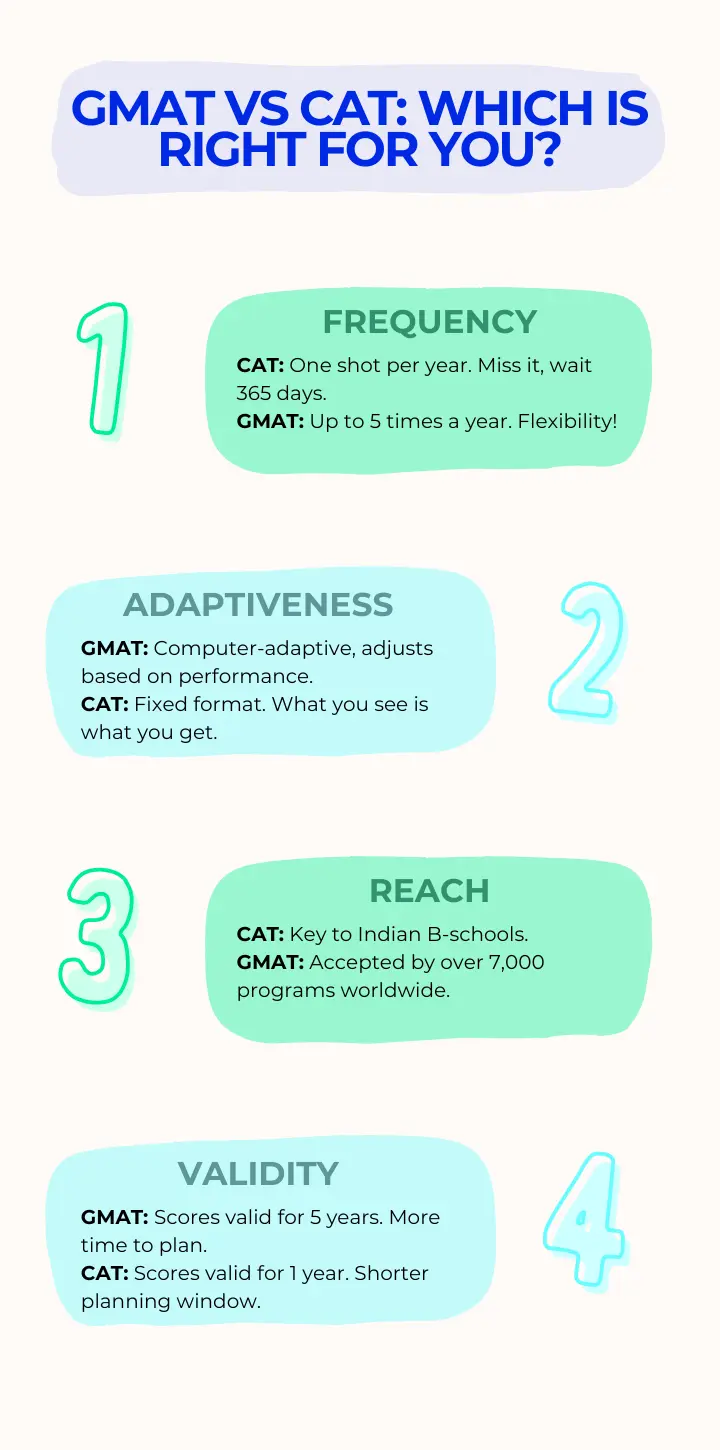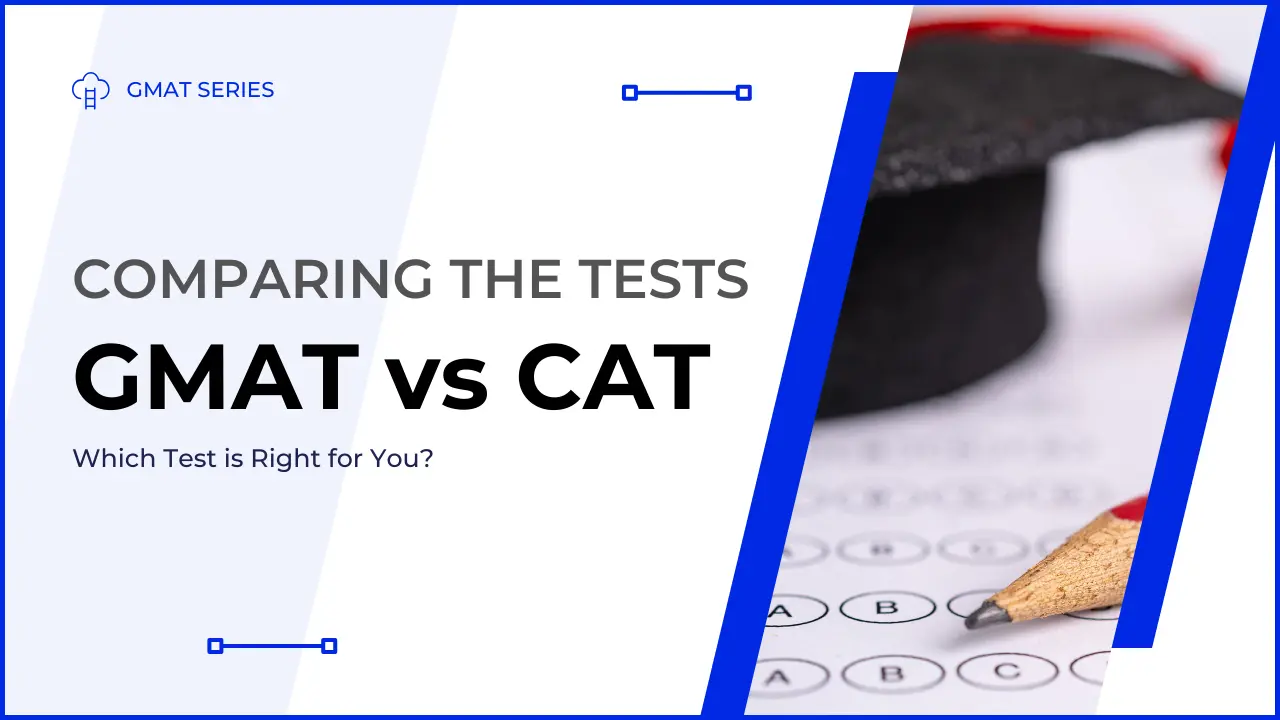Let’s face it:
Selecting between GMAT vs CAT for your MBA path is like choosing between coffee and tea. Both are excellent, but for different reasons.
You’re not alone in this dilemma. Thousands of Indian MBA aspirants grapple with this decision every year.
But here’s the kicker:
You don’t always have to choose. In fact, preparing for both exams can be your secret weapon in the cutthroat world of B-school admissions.
In this no-fluff guide, you’ll discover:
- Why considering both CAT and GMAT can 10x your chances of getting into a top B-school
- GMAT vs CAT: The nitty-gritty differences (and how to use them to your advantage)
- Battle-tested strategies to efficiently prepare for both tests without losing your sanity
- Insider tips to ace CAT and GMAT (even if you’re juggling a full-time job)
- GMAT vs CAT: Frequently asked questions
Plus, I’ll hand you a foolproof study plan that covers both exams without burning the midnight oil.
Sounds too good to be true?
Stick with me, and I’ll show you how it’s done.
Grab your free copy of ‘Demystifying GMAT FE’
Grab your free copy of ‘Demystifying GMAT Focus Edition’
1. GMAT vs CAT: Key Differences at a Glance
Now that we’ve covered why considering both exams can be beneficial, let’s dive into the nitty-gritty details.
Here’s a side-by-side comparison that’ll make your decision-making process a whole lot easier:
| Feature | CAT | GMAT Focus Edition |
|---|---|---|
| Administering Body | Indian Institutes of Management (IIMs) | Graduate Management Admission Council (GMAC) |
| Exam Duration | 2 hours | 2 hours 15 minutes |
| Number of Sections | 3 | 3 |
| Total Questions | 66 | 64 |
| Scoring Range | 0-300 | 205-805 |
| Validity | 1 year | 5 years |
| Frequency | Once a year | Multiple times a year |
| Adaptiveness | Non-adaptive | Computer-adaptive |
| Negative Marking | Yes (-1 for MCQs) | No but there is a penalty |
| Global Acceptance | Limited to Indian B-schools | Worldwide acceptance |
But here’s the point to note:
While these differences might seem straightforward, they have a massive impact on your preparation strategy and career prospects.
For instance:
- Frequency:
- With CAT, you’ve got one shot per year. Miss it, and you’re waiting 365 days for another crack.
- GMAT? You can take it up to 5 times a year. Talk about flexibility!
- Adaptiveness:
- GMAT’s computer-adaptive format means the difficulty adjusts based on your performance. It’s like a personalized challenge, pushing you to your limits.
- CAT, on the other hand, is a fixed beast – what you see is what you get.
- Global Reach:
- Sure, CAT is the golden ticket for Indian B-schools.
- But GMAT? It’s your passport to over 7,000 programs worldwide. That’s a whole lot of options, folks.
- Validity:
- GMAT scores are valid for a whopping 5 years.
- CAT? Just one. If you’re playing the long game, GMAT gives you more breathing room.
Here’s the bottom line:
Choosing the right test isn’t just about the exam itself. It’s about how well it fits with your career goals and personal situation.
In the next section, we’ll dive into how you can leverage the syllabus overlap between these exams to supercharge your prep.
2. GMAT vs CAT Syllabus Overlap: Maximizing Your Prep Efficiency
Here’s the not-so-good news:
When you’re juggling CAT and GMAT prep, time is your most precious resource.
But here’s the good news:
These exams have a ton of overlap. And I’m not just talking about a few similar questions here and there.
Check this out:
| Section | Overlap Percentage |
|---|---|
| Quantitative | 70-80% |
| Verbal | 50-60% |
| Reasoning | 40-50% |
That’s right – up to 80% overlap in some areas!
So, what does this mean for you?
It means you can supercharge your prep by focusing on these common areas.
Here’s how it works:
- Quantitative Reasoning:
Both exams focus on arithmetic and algebra, but only CAT dives into Geometry. - Verbal Reasoning:
Reading Comprehension is king for both tests. - Logical Reasoning:
CAT’s DILR section is your secret weapon for cracking GMAT’s Data
Here’s what you need to remember:
By strategically tackling these overlapping areas, you’re essentially killing two birds with one stone. It’s like getting a 2-for-1 deal on your MBA prep!
But hold on, there’s a catch:
While there’s significant overlap, each exam has its unique flavors.
And in the next section, we’ll dive into those differences that could make or break your scores.
Learn more about the GMAT Focus Edition Syllabus here.
3. Unique Elements: What You Need to Study Separately
Here’s the deal:
While CAT and GMAT Focus Edition have some overlap, they’re not carbon copies. Each exam has its own special sauce that you need to master.
Let’s break it down:
CAT-specific Topics
- Data Interpretation & Logical Reasoning (DILR):
This is CAT’s secret weapon. It’s like solving a puzzle while juggling numbers. - Non-MCQ Questions:
CAT throws in some Type in the Answer (TITA) questions. No options to choose from here, folks! - Indian Context:
CAT often uses passages and scenarios relevant to the Indian business landscape.
GMAT Focus Edition-specific Topics
- Data Insights Section:
This is GMAT’s new powerhouse. It combines elements of data sufficiency, multi-source reasoning, and data analysis. - Tough Critical Reasoning:
GMAT’s verbal section loves to test your logical thinking skills. - Problem Solving with a Twist:
While both exams have quant sections, GMAT Focus Edition emphasizes applied math in business contexts.
Don’t worry!
While these unique elements might seem daunting, they’re actually your ticket to standing out.
Master these, and you’ll have a leg up on the competition.
But remember:
It’s not just about studying more. It’s about studying smart. In the next section, we’ll dive into how to manage your time effectively while preparing for both exams.
Grab your free copy of ‘Demystifying GMAT FE’
Grab your free copy of ‘Demystifying GMAT Focus Edition’
4. Time Management: Balancing CAT and GMAT Preparation
Listen up, because this is where the rubber meets the road:
Preparing for both CAT and GMAT simultaneously isn’t just about studying harder – it’s about studying smarter.
And that all comes down to one thing: time management.
Here’s the deal:
You’ve got 24 hours in a day, just like everyone else. But by the end of this section, you’ll know how to squeeze every ounce of productivity out of those hours.
Let’s break it down:
The 80/20 Rule of MBA Prep
Ever heard of the Pareto Principle?
It states that 80% of your results come from 20% of your efforts. Here’s how to apply it to your CAT and GMAT prep:
- Identify High-Impact Topics:
Focus on areas that are crucial for both exams. Remember that overlap we talked about earlier? That’s your best shot. - Prioritize Weak Areas:
Don’t waste time on what you already know. Zero in on your weaknesses and turn them into strengths. - Use Targeted Practice:
Quality over quantity, folks. One well-analyzed practice question is worth ten rushed ones.
The Ultimate Dual-Prep Study Plan
Enough theory. Let’s get practical.
Here’s a sample weekly study plan that covers both CAT and GMAT:
| Day | Morning (1.5 hrs) | Evening (2 hrs) | Weekend (4 hrs) |
|---|---|---|---|
| Mon | CAT Quant | GMAT Verbal | - |
| Tue | GMAT Quant | CAT Verbal | - |
| Wed | CAT DI/LR | GMAT Data Insights | - |
| Thu | GMAT CR & RC | CAT RC | - |
| Fri | Mock CAT (sectional) | GMAT AWA | - |
| Sat | - | - | Full-length GMAT |
| Sun | - | - | Full-length CAT |
Pro Tip: Adjust this plan based on your strengths and weaknesses. Remember, flexibility is key!
Time-Saving Hacks for the Busy MBA Aspirant
- Pomodoro Technique:
Study in 25-minute focused bursts, followed by 5-minute breaks. It’s like HIIT for your brain! - Spaced Repetition:
Review topics at increasing intervals. It’s scientifically proven to boost retention. - Dual-Purpose Practice:
Use GMAT practice questions to prep for CAT’s non-MCQ section. Two birds, one stone! - Mobile Learning:
Utilize apps and podcasts during commutes or downtime. Every minute counts! - Study Groups:
Join online forums or local study groups. Explaining concepts to others cements your own understanding.
Expert Tips for Excelling in Both Exams
- Start Early:
Give yourself at least 6 months for dual prep. Rome wasn’t built in a day, and neither is a stellar MBA application. - Consistency is Key:
It’s better to study for 1 hour every day than 7 hours once a week. Make it a habit! - Simulate Real Exam Conditions:
Take full-length practice tests under timed conditions. It’s the closest you’ll get to the real deal. - Analyze Your Performance:
Don’t just focus on your scores. Understand why you got questions wrong and how to avoid those mistakes. - Stay Updated:
Both exams evolve. Follow official CAT and GMAT channels for the latest updates and changes.
Getting ready for both CAT and GMAT requires the right approach and determination, to ace it successfully.
In the next section, we’ll dive into specific test-taking strategies for each exam.
5. Test-Taking Strategies: Adapting to Different Exam Formats
We’ve covered the prep work.
Now let’s get into the nitty-gritty of test day strategies.
Because let’s face it – all that studying won’t mean squat if you can’t bring your A-game when it counts.
Here’s what you need to know:
CAT and GMAT Focus might be cousins, but they’ve got some key differences.
And if you want to ace both, you need to know how to switch gears quickly between both the tests.
Let’s break it down:
CAT: The Sprint
CAT is like a 100-meter dash. It’s fast, it’s furious, and every second counts.
Here’s how to crush it:
-
Sectional Time Management:
You’ve got 40 minutes per section. No more, no less. -
No Going Back:
Once you’ve answered, it’s sayonara. No second chances. -
Negative Marking:
Wrong answers will cost you.
GMAT Focus: The Strategic Marathon
GMAT Focus is more like a chess match. It’s all about strategy and adaptability.
Here’s your game plan:
- Adaptive Testing:
The difficulty adjusts based on your performance. - Review and Edit:
You can change up to 3 answers per section. - Data Insights:
This new section is GMAT’s wild card.
The Hybrid Approach: Becoming a Test-Taking Chameleon
Now, here’s where it gets interesting.
To excel in both exams, you need to be more adaptable than a ninja in combat.
Here’s how:
- Flexible Pacing:
Master the art of switching between CAT’s sprint and GMAT’s marathon. - Diverse Question Types:
CAT’s DI/LR and GMAT’s Data Insights might look different, but they both test your data skills. - Mental Stamina:
GMAT Focus is longer, CAT is more intense. Build that mental muscle to handle both. - Adaptable Strategies:
Learn when to use CAT-style quick elimination and when to go for GMAT-style deep analysis.
Mastering these different formats will help develop a versatile skill set that’ll make you a business world ninja.
6. GMAT vs CAT: Scoring Systems Compared
Alright, folks. We’ve covered the prep work and test-taking strategies.
Now let’s dive into the nitty-gritty of how these exams are actually scored.
Because let’s face it – understanding the scoring system is half the battle.
Here’s the tl;dr version:
CAT and GMAT use completely different scoring systems.
And if you want to ace both, you need to know exactly what you’re up against.
Let’s break it down:
CAT Scoring: The Percentile Game
CAT scoring is all about percentiles. Here’s how it works:
- Raw Score Calculation:
Correct answer: +3 points - Normalization Process:
CAT is conducted in multiple slots, so scores are normalized to ensure fairness. - Percentile Calculation:
Your percentile shows what percentage of test-takers you outperformed.
GMAT Focus Edition Scoring: The 805-Point Scale
GMAT Focus Edition uses a revamped scoring system. Here’s the lowdown:
- Total Score:
Range: 205-805 - Section Scores:
Each section is scored on a scale of 60-90 - Adaptive Testing:
The difficulty of questions adapts based on your performance
Here’s the scoop:
While CAT percentiles change every year based on the performance of all test-takers, GMAT scores are more stable.
A GMAT score of 705 holds the same value year after year. So, it doesn’t matter when you took the test within its 5-year validity period.
The Bottom Line: What This Means for You
-
For CAT:
Focus on outperforming others. Your absolute score matters less than your relative performance. -
For GMAT:
Aim for a specific score. Most top B-schools have a GMAT score range they prefer. Keep in mind that schools will be adapting to the new 205-805 scale. -
Prep Strategy:
For CAT, practice with past year papers to get a feel for the percentile system. For GMAT, use official practice tests to gauge your score accurately on the new 805-point scale.
Remember:
Understanding these scoring systems will help you tailor your test-taking strategy to maximize your performance on each exam.
In the next section, we’ll dive into how to leverage your scores for applications to both Indian and global B-schools.
Grab your free copy of ‘Demystifying GMAT FE’
Grab your free copy of ‘Demystifying GMAT Focus Edition’
7. Application Strategy: Leveraging Your Scores for Indian and Global B-Schools
Alright, future MBA rockstars. Let’s talk strategy.
How can you use your CAT or GMAT scores to maximize your chances of getting into a top B-school?
Let’s break it down:
For Indian B-Schools:
- IIMs and Top-Tier Indian Schools:
CAT is your golden ticket here - GMAT-Accepting Indian Programs:
Surprise! Many top Indian schools now accept GMAT scores
For Global B-Schools:
- Top US and European Schools:
GMAT is your passport here - The 700 Club:
Most top schools look for 700+ scores (90th percentile and above)
The Strategic Approach:
- Know Your Goals:
Aiming for a 2-year program right after college? CAT might be your best bet - Leverage Your Experience:
Fresh graduate? CAT-based programs might favor you - Diversify Your Options:
Consider preparing for both if you’re open to various program types
Understanding the nuances of CAT and GMAT acceptance can help you make smarter decisions.
While CAT offers a traditional path to top Indian schools, GMAT opens up both global and executive program options in India.
But remember: It’s not just about getting in. It’s about finding the right fit for your career goals.
8. Conclusion: Making Your Final Decision
We’ve covered a lot of ground, from the nitty-gritty of CAT and GMAT Focus Edition to expert strategies for conquering both. Now it’s time to bring it all home and help you make that final decision.
Here’s the final say:
Preparing for CAT and GMAT together will give you a great advantage when it comes to hedging your risks.
But it’s not for everyone.
Let’s break it down one last time:
When to Go All-In on Both Exams:
- You’re Aiming for the Stars:
If you’re gunning for top Indian B-schools AND dreaming of global MBA programs, this dual approach is your golden ticket. - You’ve Got Time on Your Side:
With 6-8 months of dedicated prep time, you can tackle both exams without losing your sanity. - You’re a Versatility Ninja:
If you thrive on diverse challenges (hello, GMAT’s new Data Insights section!), prepping for both can actually keep you more engaged.
When to Choose One Over the Other:
- CAT is Your Jam:
If your heart is set on IIMs or other top Indian B-schools, CAT is still the reigning champ. - GMAT Focus for Global Aspirations:
With its worldwide acceptance and the new, more business-relevant format, GMAT Focus is your passport to international MBA programs. - Time is Tight:
If you’re short on prep time, focusing on one exam will likely yield better results than spreading yourself thin.

The Bottom Line:
Whether you choose to tackle both CAT and GMAT Focus or focus on one, remember this:
Your exam scores are just one part of your MBA application. Your work experience, essays, and interviews all play crucial roles in landing you that coveted B-school seat.
- So, here’s your final game plan:
- Assess your goals honestly
- Consider your time and resources
- Make a decision and commit to it 100%
- Use the strategies we’ve covered to crush your chosen exam(s)
- Build a stellar overall application
Remember, the journey to your dream MBA is a marathon, not a sprint. Stay focused, stay determined, and most importantly, believe in yourself.
You’ve got this, future business leaders. Now go out there and make it happen!
P.S. Got more questions? Hit us up in the comments.
We’re here to help you navigate this exciting journey!





0 Comments